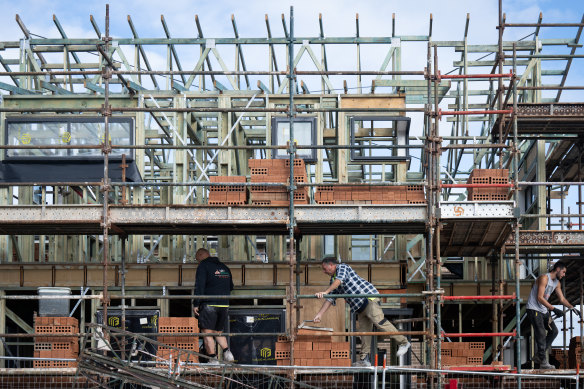- Exclusive
- Politics
- NSW
- Housing crisis
This was published 7 months ago
The new way of building housing that could lower construction costs by 20 per cent
By Max Maddison
An audacious plan to build thousands of affordable and long-term rentals for essential workers has gained the backing of business and unions, who believe the idea could solve two intractable problems and resolve inefficiencies embedded in the construction of housing.
Funded by superannuation capital, the project’s backers believe an innovative, off-site manufacturing process could reduce costs by more than 20 per cent, potentially creating a blueprint for lower-cost building as the nation struggles to construct 1.2 million homes by mid-2029.
Conceived by Business NSW executive director David Harding, the concept of tapping into vast superannuation capital to construct housing on latent government land for essential workers has received support from Unions NSW and the McKell Institute, a Labor-aligned think tank.

An innovative policy seeks to build long-term rentals for essential workers. Credit: Louie Douvis
The overarching policy is included as a recommendation in the McKell Institute’s submission to a NSW parliamentary select committee on essential worker housing established by independent MP Alex Greenwich.
The long-term build-to-rent model would see the government lease surplus public land adjacent to services to institutional investors at advantageous rates. The construction of housing stock would be provided exclusively for essential workers. Once costs and a return of investment were recouped, the land could be returned to the state government, the policy brief states.
Harding said the return on investment was likely to be around 20 years. If given the green light from government, the pilot would see about 5000 dwellings built.
It aims to break the housing market’s continuum that requires values to increase ahead of wages, providing essential workers with both the ability to live near their place of employment and save up enough for a deposit to enter the market – what Unions NSW secretary Mark Morey described as the “biggest problem”.
“And if you’re paying high rents in Sydney, there’s no way you can build up any equity to actually get a deposit or come near getting ready deposits. So that’s why I think using latent land,” he told this masthead.
One of the problems Harding believed his super housing policy had solved was creating an affordable housing investment that could stand on its own two feet financially, opening up the vast reserves capital held by superannuation funds.

Unions NSW secretary Mark Morey has backed the super housing proposal aimed at providing affordable rentals for essential workers. Credit: Peter Rae
Under legislation, funds are compelled to act in members’ best financial interest. Because of these enshrined requirements, affordable housing has never been a sufficiently attractive investment proposition for super funds.
The unlikely alliance implored government to force recalcitrant departments and agencies to release unneeded surplus land that was currently propping up balance sheets, helping disrupt Sydney’s spiralling housing affordability crisis.
The government has incrementally rolled out less than a third of the 44 sites identified as part of an audit of unused Crown land, after more than a year in the works. In late September, Minns acknowledged the process had not been quick, attributing the delay to marshalling agencies.
Harding has sought out Professor Mathew Aitchison, chief executive of a research centre focused on innovating the building sector, to find methods of delivery that overcome embedded inefficiencies in a marketplace and industry he described as unhealthy.
Aitchison said using a standardised approach and building off-site could reduce costs by one-fifth, and was an integral element of making super housing viable for institutional investors.
Start the day with a summary of the day’s most important and interesting stories, analysis and insights. Sign up for our Morning Edition newsletter.